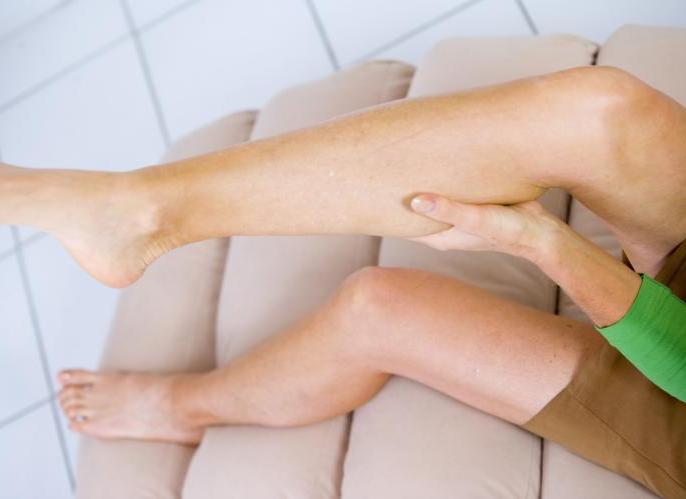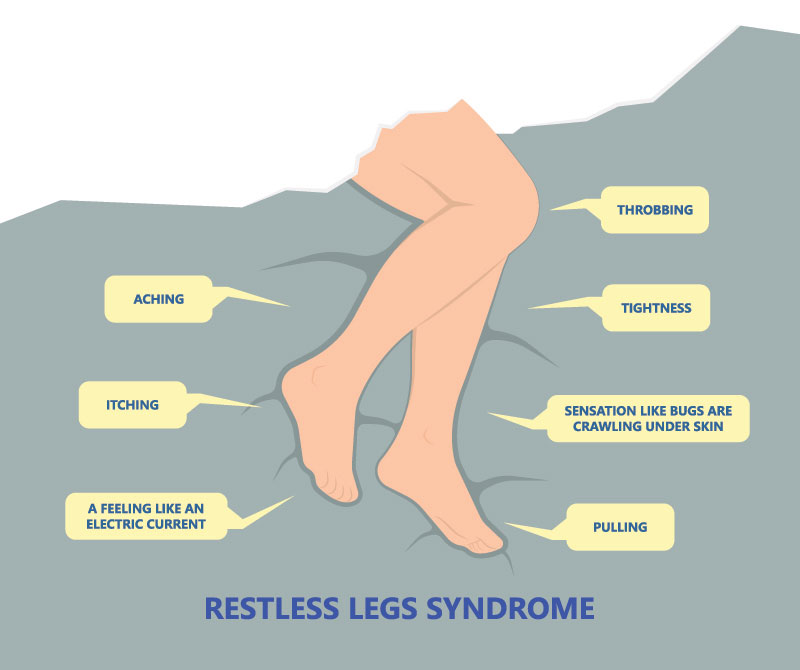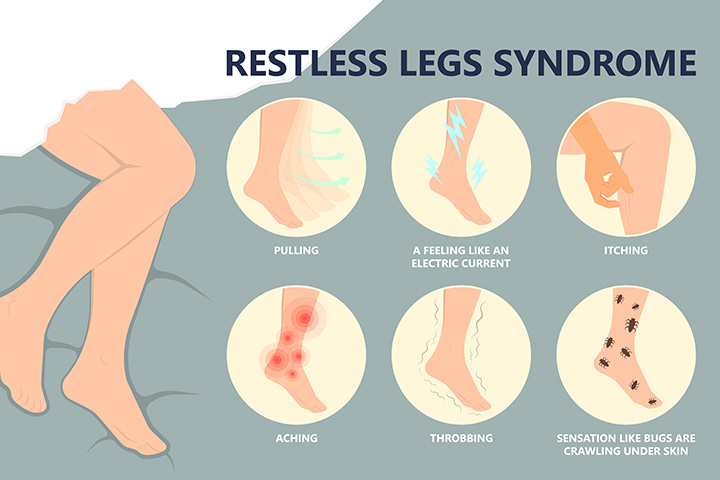Restless leg syndrome; also known as Willis-Ekbom disease, is a nervous system related disorder. People suffering from restless leg syndrome experience twitchiness as well as discomfort usually in the late afternoon or evening hours, and might become most severe at night when a person is resting, like sitting or lying in bed or when someone is inactive for a long period of time.
This leads to insomnia hence also considered as a sleep disorder. This can affect the person both mentally and physically. About 1 out of 10 people are affected by restless leg syndrome once in their life.
People of any age, including children can be affected by restless leg syndrome. Symptoms may appear in children or adults but might worsen with age. Women tend to suffer more than men from restless leg syndrome.
In severe cases people may experience periodic limb movement of sleep (PLMS) which is characterized by involuntary limb (leg or arm) twitching or jerking during sleep for a short time or throughout the night.

CAUSE OF RESTLESS LEG SYNDROME
Restless leg syndrome is hereditary and can be passed from parents to children. 92% of people suffering would have a first degree relative having the syndrome. These people would develop the symptoms in the early stage of life i.e. before the age of 45 in comparison to people without the genetic link.
Restless Leg syndrome is found to be related to abnormalities in neurotransmitters called dopamine (brain chemicals) which help in regulating muscle movement. Dopamine is like a messenger between the nervous system and brain to help regulate and coordinate the movement in the body.
They might also be related to abnormalities in the central part of the nervous system which is responsible for controlling the automatic movement. Researchers are still trying to study the reason for the syndrome.
Restless leg syndrome can also be caused by various medical conditions like iron-deficiency anemia, peripheral neuropathy, Parkinson’s, varicose veins, fibromyalgia, hyper or hypothyroidism, Amyloidosis, lyme disease or Rheumatoid arthritis and Sjögren syndrome.
Some medications or substances like Alcohol, Caffeine, Anticonvulsant drugs (like Dilantin), Antidepressant drugs (like amitriptyline, Paxil), Beta-blockers, Antipsychotics or withdrawal from certain drugs, such as vasodilator drugs (for example, Apresoline), sedatives or antidepressants (like Tofranil) might also trigger restless leg syndrome.

SYMPTOMS OF RESTLESS LEG SYNDROME
Symptoms usually occur when a person is inactive for a long period of time. The main symptom is the uncontrolled urge to move the legs and an uncomfortable sensation in legs, arms, chest or face.
People often describe the sensation as tingling, burning, itching or throbbing, “creepy-crawly” feeling in limbs, feeling like fizzy water is inside the blood vessels in the legs and a painful cramping sensation, mainly in the calves. These sensations could be mild to unbearable and severe which often reduce with movement of the legs.
In some severe cases people might experience periodic limb movements in sleep (PLMS). During sleep the leg will jerk or twitch uncontrollably. The movement could be brief and repetitive usually for 20 to 40 seconds.
Restless leg syndrome causes difficulty in falling asleep or staying asleep which leads to sleep disorders. This leads to mood swings, depression, irritability, damage to the immune system and other physical as well as health related problems.
Symptoms may worsen with time for primary or idiopathic restless leg syndrome. The symptoms may range from weeks or months for some people.
DIAGNOSIS OF RESTLESS LEG SYNDROME
Restless leg syndrome cannot be diagnosed by a particular test.. Looking at the clinical analysis below the healthcare provider would diagnose the syndrome:
- A strong and irresistible urge to move the legs which might be associated with abnormal, unpleasant, or uncomfortable sensations.
- Urge to move the legs starts or worsen during rest or inactivity.
- The need to move the limbs is partially or totally relieved by movements of the limbs.
- The urge to move legs starts and might be aggravated in the evening or night.
- The above conditions are not related to any other medical or behavioral condition.
The physician focuses on the symptoms of the patient, triggers and relieving factors. Iron deficiency is also linked with restless leg syndrome which can be detected by blood tests as well as other medical disorders.

TREATMENT OF RESTLESS LEG SYNDROME
The symptoms are relieved with moving the limb. It is important to treat the associated medical condition like peripheral neuropathy, diabetes, or iron deficiency anemia to get relief from restless leg syndrome. Physicians prescribe iron supplements in case the syndrome is due to iron deficiency anemia. Below treatment regime provides relief to the people suffering from restless leg syndrome:
- Lifestyle changes – Changes like avoiding or decreasing the use of alcohol and tobacco, adopting moderate exercise, maintaining a regular sleep pattern, massaging the legs, taking a warm bath, and using a heating pad or ice pack might provide relief to patients with mild to moderate symptoms. Stretching exercises or aerobics done with moderate intensity may provide relief from mild symptoms. Using foot wraps that put pressure underneath the foot as well as massaging at the back of the legs is also proven to provide relief from symptoms and ensure better sleep.
- Iron Intake – people with low iron levels in the body are prescribed iron supplements. Sometimes iron might not be well-absorbed by the gut and cause constipation. Hence, stool softeners are prescribed along with iron supplements. In some cases, where iron supplements are not capable of increasing the level of iron in the body they might require iron to be injected directly in the bloodstream through IV.
- Anti-Seizure medication – These help in providing relief from sensory disturbances like creeping, crawling and nerve pain. Some people may experience side effects like sleepiness, fatigue and dizziness from these medications. Common anti-seizure drugs prescribed are gabapentin and pregabalin.
- Dopaminergic agents – This medication helps in increasing the dopamine levels. This helps in reducing the muscle cramping as well as involuntary movements of the legs. Long-term use of these medications might worsen the condition like symptoms which occur in evening or late night might happen throughout the day. Once the medication is stopped the symptoms can be reversed or improved.
- Opioids – These help in relieving pain and relieving symptoms of restless leg syndrome when other medications fail. Very low doses of medicines like codeine, oxycodone, and acetaminophen are effective in reducing restless leg syndrome.
Muscle relaxants and sleep medication help in peaceful sleep but don’t eliminate leg sensation. This might make people drowsy during the daytime. Some medications like antidepressants, antipsychotic and anti-nausea drugs might worsen the condition.
OUTLOOK
Restless leg syndrome might become a lifelong condition that doesn’t have a cure. It is sometimes unrecognized or misdiagnosed. With current therapies the disorder can be controlled with minimized symptoms and better sleep.
The symptoms might worsen with age which might be associated with different medical conditions. It is important to maintain a healthy weight with regular exercise, give up smoking (if people with restless leg syndrome smoke), and eat a balanced diet to reduce the symptoms of restless leg syndrome.
If you or anyone you know is suffering from Restless Leg Syndrome, our expert providers at Specialty Care Clinics will take care of your health and help you recover.
Call us on (469) 545-9983 to book an appointment with Dr. David Masel.
